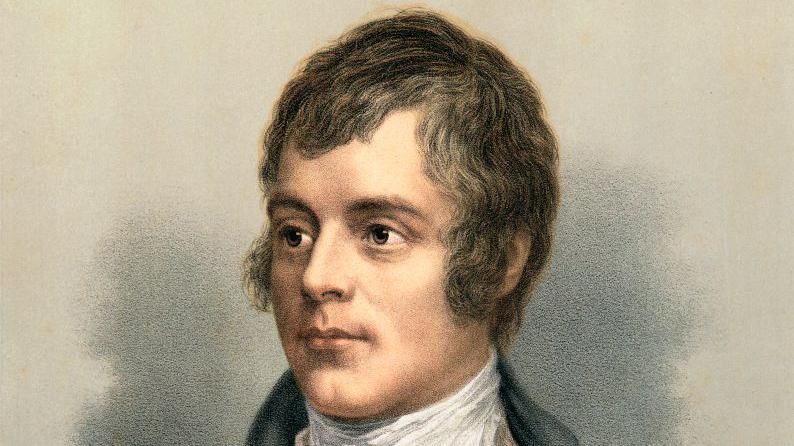Burns Night: Who was Robert Burns and why do we celebrate his work?

Robert Burns died in 1796, at the age of 37
- Published
Burns Night is celebrated every year on 25 January in honour of Scotland's national poet, Robert Burns.
The Ayrshire poet and lyricist died in 1796, at the age of 37, but he is still regarded as the most prominent poet to have written in the Scots dialect.
His most well-known poems include To a Mouse, Address to a Haggis, Tam O'Shanter, A Red, Red Rose and The Selkirk Grace.
Alongside his literary contributions, Burns gained fame for his numerous love affairs and radical political leanings, expressing sympathy for the French and American revolutions.
What is Burns Night?
A traditional Burns supper of haggis, neeps and tatties
Burns Night, or Burns Supper, is traditionally celebrated with a dinner consisting of haggis, neeps, and tatties, external - more commonly known as turnips and potatoes.
On the 21 July 1801, the fifth anniversary of his death, his friends gathered at what is now called Burns Cottage in Alloway, near Ayr, where he was born, to honour his memory.
During this gathering, they read aloud some of his works and poetry. One poem, 'Address to a Haggis,' was recited as they dined on haggis and a sheep's head.
Unbeknown to them, this event marked the beginning of a tradition that has endured for 200 years and continues to be celebrated today.
In the years following, Burns clubs started to emerge across Scotland to celebrate his life.
When is Burns Night?
The Selkirk Grace is often said before tucking into haggis, neeps and tatties
In 1802, the celebration was shifted from the date of Burns' death to his birth date.
However, they initially got the date wrong, meeting four days after his actual birth.
It wasn't until the following year, in 1803, when members of what is known as the 'Mother Club', the Greenock Burns Club, discovered through Ayr parish records that his true birth date was 25 January.
This date has been celebrated with Burns Suppers for more than 200 years.
Burns' birthplace, Burns Cottage, in Alloway, is now a museum
When was Robert Burns born?
Burns started life in Alloway, South Ayrshire, in 1759, the eldest of seven children born to William Burns and Agnes Broun, from a relatively poor farming family.
He began working in the fields at a young age and by 15, he had become the primary labourer. His farming upbringing is why he is often referred to as the ploughman's poet.
His father, a self-educated man, decided to home-school his children with the help of tutors.
It was during these formative years that Burns made his initial attempts at writing poetry for various friends and in pursuit of women.
As he matured, he had a growing interest in poetry, nature, women, and drinking - rather than farm work - much to his father's dismay.
Statues of Robert Burns can be found all across Scotland and the world
Burns was known to have had many affairs throughout his life.
In 1785, his affair with a servant girl named Elizabeth Paton, resulted in an illegitimate child.
Jean Armour, a woman who became a constant presence in his life, became pregnant the following year.
Burns sought permission to marry her but Jean's father refused.
Annoyed by this, Burns planned to travel to Jamaica with another woman named Mary Campbell, who tragically died shortly after.
She is more commonly known today as Highland Mary.
After Mary's death, Burns still attempted to gather funds to leave for Jamaica.
However, in 1786, he published his first collection titled 'Poems, Chiefly in the Scottish Dialect', widely known as the Kilmarnock edition.
These poems garnered rapid success, making him known across Scotland.
He postponed his intended trip to Jamaica.
Where did Robert Burns live?
Burns spent the last years of his life in Dumfries
An Edinburgh edition of Poems, Chiefly in the Scottish dialect brought more fame, money and an entrance into polite society.
He was received as an equal by the city's men of letters and was a guest at aristocratic gatherings.
In 1788, Burns moved to Dumfries, where he leased a farm, external, and married Jean Armour.
But the poet was leading a double life.
He engaged in correspondence and produced poems and songs with individuals who were considered socially superior, all the while working as a tenant farmer and an exciseman.
His outspoken support for the French revolution nearly cost him his job, as he openly expressed his pro-revolutionary views.
He died in 1796 after his health had rapidly declined.
On the day of his funeral, Jean Armour gave birth to his final son, Maxwell.
He left behind five surviving children out of the 12 born, along with his wife.
When she died 38 years later in 1834, she was buried next to him.
What is the impact of Robert Burns today?
Auld Lang Syne is traditionally sung to bid farewell to the old year
His life is remembered and celebrated worldwide, as his work inspired generations of Romantic poets such as William Wordsworth and Samuel Taylor Coleridge.
His musical compositions have become integral to traditions worldwide.
Auld Lang Syne, which Burns based on an older Scottish folk song, is traditionally sung to bid farewell to the old year at the stroke of midnight on Hogmanay (New Year's Eve)/Hogmanay.
The melody of "Auld Lang Syne" is played worldwide at various events, each carrying different cultural significance.
In Japan, for instance, its melody is played in bars and department stores to signal closing time.
Related Topics
- Published31 December 2013
- Published19 January 2015
- Published25 January 2018
- Published25 January 2015
- Published14 November 2023
- Published18 March 2018